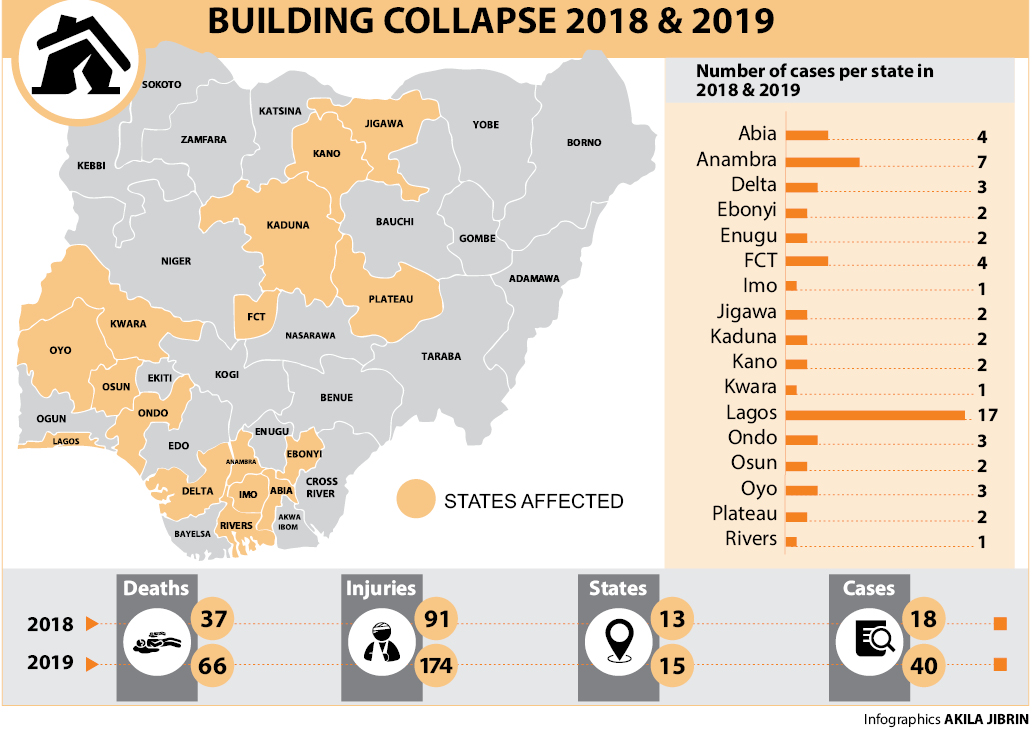- 66 die, 174 injured in 40 collapse cases
- More buildings may collapse in 2020-expert
The number of building collapse incidents in Nigeria more than doubled last year compared to 2018, just as more people died and a greater number sustained injuries, findings by Daily Trust have shown.
An analysis of data on collapsed buildings collated by Daily Trust between 2018 and 2019, showed that 40 cases of building collapse were recorded in 2019 whereas only 18 happened in the whole of 2018, representing about 122 per cent increase.
The data was compiled from routine newspaper reports of building collapse across the country. The regulators, the state emergency agency, professional bodies or the police also authenticated the incidents and confirmed the casualty figures.
Many structural failures occur yearly that are hardly reported because there is yet no up-to-date official statistics of building collapse in the country. The figures compiled are just a slice of the numerous cases that are difficult to track and report nationwide.
The data showed that two and three storey buildings, and buildings under construction collapsed more than any other type of structure last year.
The data revealed that while 66 people died and 174 sustained varying degrees of injuries from the 40 building collapse incidents in 2019, about 37 died and 91 sustained wounds from the 18 incidents in 2018.
Overall, the data showed that at least 103 people have died while 265 sustained injuries from 58 building collapse incidents in the last two years.
Lagos, followed by Anambra and Abia recorded the highest number of collapsed buildings in the country in 2019.
In Lagos, 27 people died from 15 collapse incidents; five died from four incidents in Anambra and three lost their lives from three incidents in Abia State. However, 14 deaths were recorded from just two incidents that happened in Plateau State in 2019.
In the first four months of 2019, Lagos witnessed four incidents of collapsed buildings with a total of 21 fatalities, although, one particular incident accounted for more than 90 per cent of the death toll and injuries recorded in the state within the period.
The collapse of a three-storey residential/school building on 14 Massey Street, Ita Faji area of Lagos Island, on March 13, claimed about 20 lives while 43 people sustained injuries.
The statistics seem to be consistent with previous expert estimates which put cases of building collapse in the last seven years at over 100, with Lagos recording the highest number in terms of buildings and casualties.
According to the data, the second highest mortality from collapsed building last year occurred when a three-storey building caved in in Jos, Plateau State. The National Emergency Management Agency said 14 persons died from the incident.
Following the rampant occurrences, some state governments took fresh actions by carrying out integrity tests on buildings suspected to be weak but the trend has continued despite these measures.
In response to the current wave of collapse of buildings, professional groups including building construction experts insist that strict enforcement of the building code is one sure way of mitigating building collapse.
President of the Nigerian Institute of Building (NIOB) Bld. Kunle Awobodu who agreed with the Daily Trust data said it was glaring why more buildings collapsed in 2019 and especially in Lagos.
“According to our own record, while Lagos was number one, Anambra and Plateau were next. What could have caused that? If you divide the buildings that collapsed into two areas, buildings under construction and existing buildings, you will find that the percentage of buildings that collapsed under construction was quite high, more than 50 per cent of existing buildings.
“The implication is that the monitoring and approval system was at fault. That is the building control agency in Lagos, for instance, might be questioned. The government agencies that are saddled with the responsibility of monitoring need to go back to the drawing board and re-strategise because something is definitely wrong when you are having a high number of buildings collapsing under construction.”
Awobodu said for government to reduce the collapse of buildings during construction, there is need to ensure the existing laws in the area of construction are obeyed. He said the Builders Act LFN 2004 stipulates that the responsibility of management of building sites should be handled by registered builders.
He said the NIOB will increase advocacy on the need for government and stakeholders in the built environment to ensure that existing laws were obeyed.
Also speaking, a Professor of Structural Engineering at the University of Maiduguri (UNIMAID), Lateef O. Onundi, who also corroborated the Daily Trust data, added that the reasons for the increase in collapse incidents were the delay in action on many buildings that are distressed and marked for demolition; weak and distressed buildings abandoned by owners; misuse of original buildings’ concepts that usually lead to overload and adoption of wrong methods of demolition of distressed buildings.
Others, he said were, “use of crude methods, substandard materials and poor workmanship through the use of quacks in the construction industry; wrong geotechnical assumptions and excessive loading on wrong foundation types in soils with poor safe bearing capacities leading to failures during heavy downpours and lack of prompt action for maintenance and renovations.”
Prof. Onundi said the trend will continue unless the aforementioned reasons were resolved.

 Join Daily Trust WhatsApp Community For Quick Access To News and Happenings Around You.
Join Daily Trust WhatsApp Community For Quick Access To News and Happenings Around You.


